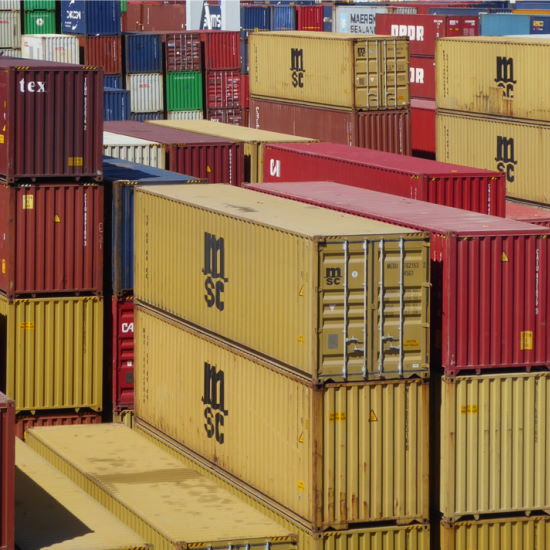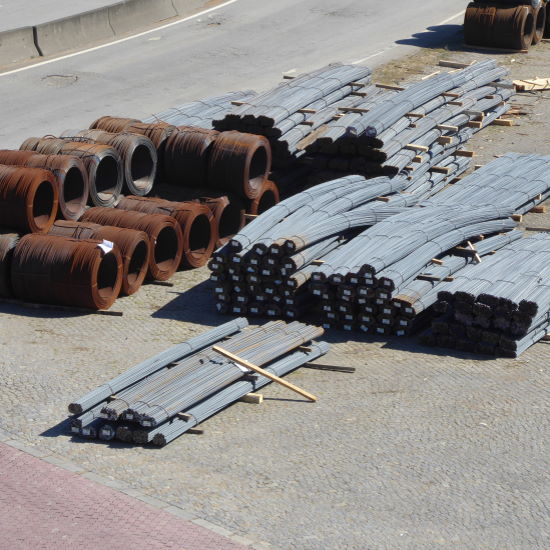The various goods transported by ocean and transiting through ports can be divided in 5 main types of cargo:
- Liquid Bulk (cca. 29% of the 2018 loaded tons for international maritime trade)
- Dry Bulk (cca. 46%)
- Containers (cca. 18%)
- Roll On Roll Off and Break Bulk. (put together – cca. 7%)
More details on each and the international maritime trade can be found below.

LIQUID BULK CARGO
Liquid cargo transported in its free-flowing liquid form (crude oil, vegetable oil, chemicals, wine…) or in its liquid gas form (natural gas, liquid petroleum gas).
Poured in or sucked out of the hold, the tanks of liquid bulk vessels by specialized port equipment, such as articulated lines pipes which are in turn connected to storage tanks. These reservoirs can be located on the quay or further away and reached thanks to a pipeline.

DRY BULK CARGO
Cargo – such as grain, sand, gravel, iron ore, cobblestones – which is homogeneous, unpacked, and transported loose in large quantities is called Dry bulk cargo.
This cargo is typically loaded by vessel or shore-cranes equipped with buckets. Offloading operations are commonly facilitated by the usage of funnels.
In more specialized terminals, conveyor belts may also be used, and storage location – such as silos for the agri-bulk dry bulk cargo – may be present.

CONTAINERS
Cargo is consolidated and transported in standard sizes shipping containers (Intermodal containers).
Various types of containers are available in standard sizes – typically 20′ and 40′ long:
• Dry (toys, fridges, TVs, clothes), • Tank (oils, fuel, beer…),
• Reefer (frozen, refrigerated goods), • Open top or Flat rack (oversized cargo).
Container terminals are commonly equipped with gantry cranes to optimize the loading and unloading operations and include a container yard supported by specialized equipment, such as reach stackers, terminal container chassis, container handlers, or straddle carriers.
Take a look at our animated container port here.

ROLL-ON ROLL-OFF
Any cargo which is rolled on or off from a vessel.
It may be self-driven (cars, buses, trailer, and tractor…) onto the vessel, or may be wheeled (unaccompanied trailers, certain construction equipment… ), or loaded onto a roll-trailer (container, generator, etc…) and towed onto the vessel.
Terminals will generally contain a storage or waiting area and – even if most RORO vessel have their own built-in ramps – may be equipped with a ramp to further ease the loading and offloading operations.

BREAK BULK
Also called General cargo, it is handled as separate pieces, loaded individually or in lots without being consolidated in a container. For example wind turbine blades, large generators, pipes, bundles of steel rods, …
Cargo may be unpacked, possibly protected by a tarp, or could be in a crate or a special transport frame.
This cargo type often includes very large and heavy items and relates to the delivery of industrial or construction projects – it may then be named Project cargo.
Typically loaded by standard shore or vessel cranes or by mobile or floating cranes.

In terms of volume and based on the available UNCTAD data and some assumptions, we can consider the following for the main cargo types:
- Liquid bulk represented 3,194 million loaded tons in 2018.
- Dry bulk represented 3,210 million loaded tons of main dry bulk (Iron ore, grain, and coal), and about 1,870 million loaded tons of “minor” dry bulks.
- Containerized cargo represented about 2000 million tons loaded and has dramatically increased over the years.
- Finally, RORO and break bulk can be estimated at about 700 million tons loaded in 2018.
Source – https://unctad.org/en/PublicationsLibrary/rmt2019_en.pdf
You can find more about these cargo types and how ports work in our How ports work – 35 minutes online course – get it for $4.99 using the 5main coupon.
Back to the resource list.


Nice inform